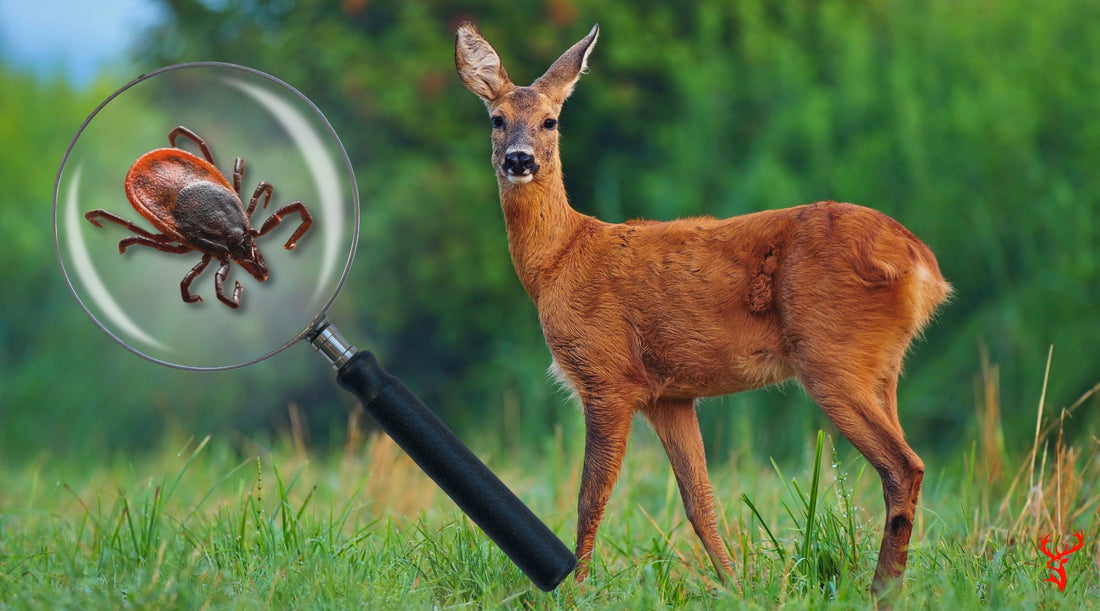In our journey through the world of gardening and outdoor enjoyment, there's one tiny but formidable obstacle that often goes overlooked until it's too late: the deer tick. These minuscule creatures can significantly impact our health, our pets, and the sanctity of our gardens.
Let's dive deeper into understanding deer ticks, recognizing their habitat, differentiating them from their cousins, and most importantly, learning effective strategies to keep them and their deer hosts at bay.
This guide is crafted to arm you with knowledge and practical tips, making your outdoor spaces safer and more enjoyable.

Understanding Deer Ticks
Deer ticks, scientifically known as _Ixodes scapularis_, are not just another insect in your garden; they are carriers of Lyme disease, among other tick-borne illnesses, which can have severe implications for human health.
These ticks are incredibly adaptable and can be found in various environments, but they thrive in humid, wooded, or grassy areas where they can easily latch onto hosts for their blood meals.
The lifecycle of a deer tick is fascinating yet concerning, as it allows them to spread diseases across different hosts. But here's a little twist – despite their name, deer ticks don't just hitch a ride on deer. They can be found on a variety of hosts, including mice, birds, and yes, even humans.
Identifying Deer Tick Habitats
These ticks prefer the shelter of dense foliage, tall grasses, and wooded areas. However, they make their way into suburban gardens and yards, especially in regions where these environments blend together.
The presence of deer and other wildlife in your garden significantly increases the risk of deer tick infestation. The ticks' ability to survive in a range of temperatures but their preference for humidity means that they are a year-round threat in many areas, with their numbers peaking during the warm summer months.

Deer Tick Versus Wood Tick: Knowing the Difference
The difference between a deer tick and a wood tick, or American dog tick, is crucial because it directly relates to the diseases they can transmit.
Deer ticks are smaller, with a distinctive red and black coloring, and are the primary vectors for Lyme disease.
On the other hand, wood ticks are larger, with a more pronounced teardrop shape, and while they can carry other diseases, they are not known for spreading Lyme disease. Recognizing the type of tick can help in understanding the potential risks and necessary precautions.
The Relationship between Deer and Deer Ticks
Deer and deer ticks share a symbiotic relationship that is crucial to the tick's lifecycle, yet problematic for humans and our environments. While deer are not the direct transmitters of diseases like Lyme disease to humans, they play a pivotal role in the proliferation and geographical distribution of deer ticks.
Adult deer ticks primarily feed and mate on large mammals, particularly white-tailed deer, which serve as key hosts. This interaction doesn't harm the deer but facilitates the ticks' reproductive cycle.
Once engorged, the female ticks drop off the deer to lay eggs in the environment, thus completing their lifecycle and beginning the cycle anew with potentially thousands of offspring.
This relationship is significant because it enables deer ticks to thrive and expand their populations in areas with high deer densities.
Consequently, regions with abundant deer populations often witness higher occurrences of tick-borne diseases in humans. It's important to clarify that while deer are critical for the ticks' survival and reproduction, the actual transmission of pathogens like the bacteria causing Lyme disease is not directly from deer to humans but through the bite of an infected tick.
However, by contributing to the health and expansion of tick populations, deer indirectly influence the rate of disease transmission to humans. Managing deer populations and minimizing contact between deer and human habitats can therefore be an effective strategy in reducing the risk of tick-borne diseases, underscoring the complex interdependence between deer, deer ticks, and human health.
The Risks Posed by Deer Ticks
The primary concern with deer ticks is their ability to transmit Lyme disease, which, if untreated, can lead to chronic health issues such as arthritis, neurological problems, and heart complications.
The initial symptoms might be mild, like a rash or flu-like feelings, making it easy to overlook the severity of a tick bite. Beyond Lyme disease, deer ticks can also spread other serious conditions like anaplasmosis and babesiosis, making their control a public health priority.
How Deer Become Vectors for Ticks
Deer play a crucial role in the life cycle of deer ticks by serving as hosts for adult ticks to feed and mate on.
While not all deer will carry infected ticks, areas with higher deer populations tend to have higher instances of Lyme disease and other tick-borne illnesses. This correlation makes deer management an essential aspect of tick control in affected regions.

Effective Strategies to Deter Deer and Reduce Tick Populations
Creating an unwelcoming environment for deer and ticks involves a multifaceted approach that combines garden management, the use of repellents, and physical barriers:
Deer-resistant planting:
Integrating plants that are unattractive to deer into your garden can naturally reduce your yard's appeal to these animals.
Fragrant herbs, certain flowers, and plants with bitter tastes are less likely to be grazed on by deer, indirectly reducing the risk of tick infestation.
Yard maintenance:
Keeping your lawn mowed, removing leaf litter, and trimming back bushes and trees can significantly decrease the areas where ticks can survive and thrive. A tidy yard is not just visually pleasing but also a strategic move in tick prevention.
Repellents:
For those looking for a high-tech solution, the Upgraded Ultrasonic Solar Deer Repeller with five adjustable modes offers an innovative way to deter deer without the use of chemicals.
This device uses ultrasonic sound waves to keep deer away from your garden, ensuring your plants are safe from grazing.
Ultrasonic Deer Repellers:
In addition to the upgraded model, the standard Ultrasonic Deer Repeller is another excellent choice for those seeking an effective and eco-friendly option to protect their gardens. These devices can be easily installed around your property to create an invisible barrier that deer are reluctant to cross.
Motion-Activated Sprinklers:
For an immediate deterrent, consider incorporating a Motion-Activated Sprinkler into your garden defense strategy. These sprinklers detect movement and release a burst of water, startling deer and other wildlife before they can nibble on your plants.
This method not only keeps deer at bay but also provides additional watering for your garden, making it a dual-purpose solution.
Physical barriers:
Fencing remains one of the most effective means to keep deer out of your garden. While installing a high fence might require an initial investment, it provides a long-term solution to prevent deer from entering your property and bringing ticks with them.
Personal protection:
When venturing into areas where deer ticks are prevalent, wearing protective clothing, using tick repellents on skin and clothing, and performing thorough tick checks after being outdoors are essential practices to protect yourself and your loved ones from tick bites.

Emphasizing Prevention and Vigilance
The battle against deer ticks is ongoing and requires a combination of knowledge, preparation, and action. By understanding the behaviors and habitats of these ticks, along with implementing strategies to deter their deer hosts, you can significantly reduce the risk of tick-borne diseases. Engaging in regular garden maintenance, utilizing effective deer repellents, and being vigilant about personal protection are key steps in creating safer outdoor spaces for you and your family.
In conclusion, while deer ticks pose a significant challenge, taking proactive measures can help manage their presence and mitigate the associated health risks. Remember, the goal is not just to enjoy our gardens and outdoor activities but to do so in a way that ensures our well-being and that of our communities. Stay informed, stay prepared, and let's work together to keep our spaces tick-free and thriving.

